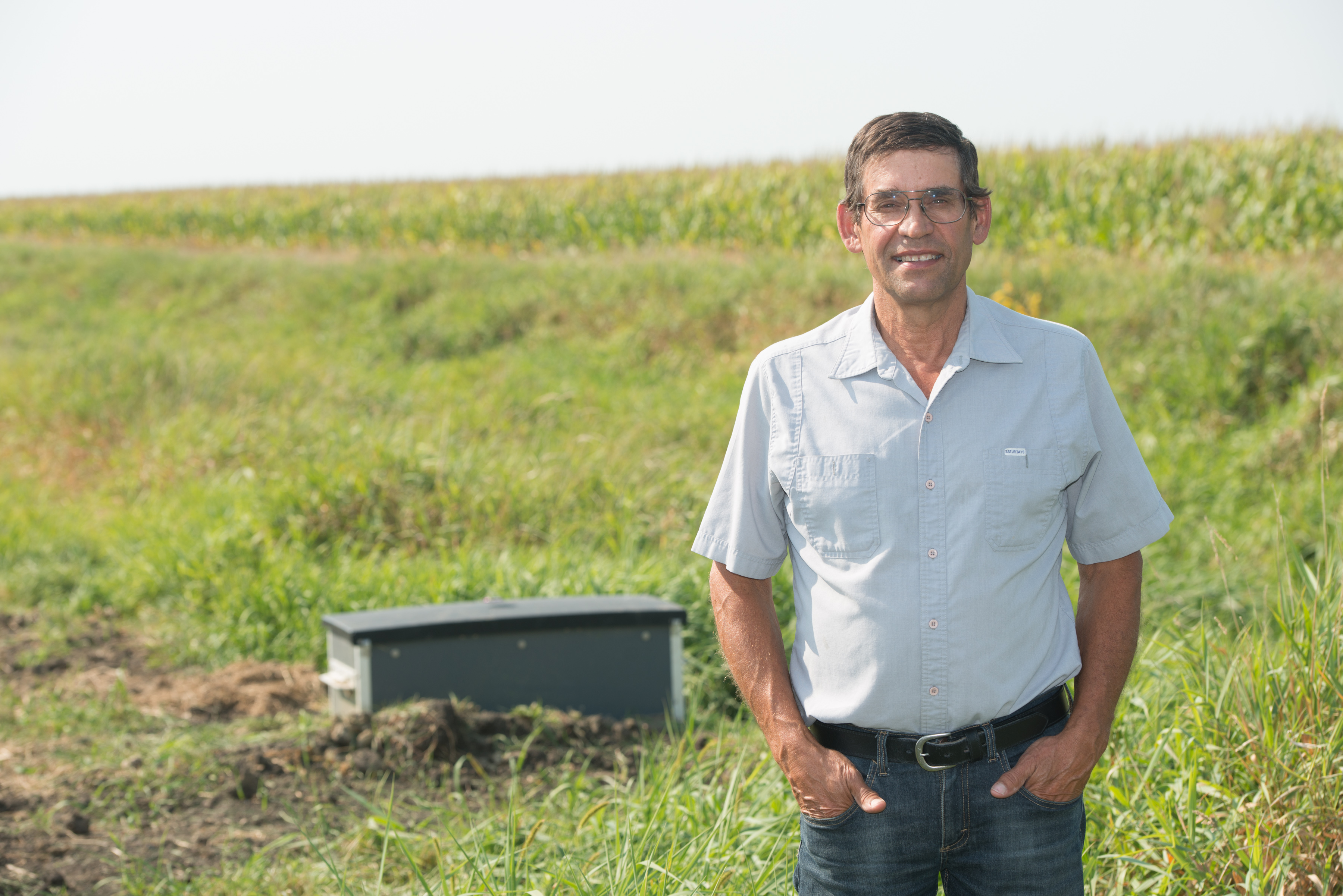
Kevin Sprung had mixed feelings about the two saturated buffers installed last summer on his farm near Osage, Iowa.
“At first, I resisted the idea. I spent a lot of time and money on tile and on improving the tile,” he says. His initial reaction was, “I don’t want to put a shutoff at the end of that.”
That’s what a saturated buffer is. A control box diverts water from an existing tile into a new tile line buried underneath a strip of grass or other vegetation along a stream bank. As water seeps from those lines toward the stream bank, it slowly reaches the stream, allowing plant roots and soil microbes to remove nitrates.
Sprung’s farm is in the Rock Creek watershed in Mitchell County. The watershed is on the way to having the nation’s biggest concentration of edge-of-field practices for improving water quality. Led by a farmer advisory board, the Rock Creek Water Quality Initiative is one of Iowa’s first and most ambitious steps in meeting the Iowa Nutrient Reduction Strategy (Iowa NRS).
A plan developed by the Iowa Soybean Association envisions protecting all the watershed’s row crop acres with cover crops, improved fertilizer management and no-till or strip-till over a period of 25 years. The plan also calls for installing 25 edge-of-field practices, which the Iowa Agriculture Water Alliance will help fund. The goal is a 41 percent reduction in nitrates and 29 percent drop in phosphorus in Rock Creek. The watershed flows into the Upper Cedar River, which eventually supplies drinking water to 120,000 consumers in Cedar Rapids

“We all need to do our part,” says Sprung, who has accepted the task of controlling the water levels in the buffer as another part of managing his farm. (When too much water is flowing from tiles, the control box sends water directly to the stream, preventing it from backing up into crops).
For a decade, Sprung has managed nitrogen on his fields with three split applications. But this year he took a big leap into a higher level of conservation. He hired custom strip tillage and he seeded 110 acres to cover crops in late summer. He now has two saturated buffers on the farm. This spring, he will install a bioreactor in another field and it will divert tile water through a buried trench filled with wood chips to remove nitrate.
Sprung is part of a second wave of farmers who are speeding up conservation work in the watershed, says Tracy Church, the coordinator of the Rock Creek project and who works out of the Mitchell County Natural Resources Conservation Service office.
The plan was approved in 2013 and a few farmers started adopting practices in 2014. But over the past year, interest has grown. Church and the first farmers involved have had eight meetings that drew up to 75 farmers at each, wanting to learn more.
At the meetings, the farmers who have already tried reducing tillage or planting cover crops were open about the challenges they’ve faced, she says. “We keep the meetings pretty open, where it’s a conversation instead of preaching,” says Church.
Those who’ve held back on implementing new conservation practices have practical reasons.
“I think the biggest one is money and equipment,” says Church. But farmers in the watershed don’t have to make big investments at first.
“We’re lucky to be able to offer custom drilling and aerial application for cover crops and custom strip till,” she says.

Hiring conservation work was an approach used by Al Witt and Bruce Johnson, who farm 2,600 acres in the watershed. For four years, local farmer Dean Sponheim did their strip tillage.
“We took those four years to collect our own data and to let the numbers tell us the story,” Witt says. They didn’t see the yield drag skeptics had predicted. By eliminating tillage passes, they also saved money. “Once you do all the math on tillage and time, it’s easily $50 an acre positive impact,” he says. They bought their own strip tillage machine this year and use it on all of their corn and soybean acres.
Witt’s business partner, Johnson, has started seeding cover crops after being inspired by a field day at Sponheim’s farm. It was held a day after a one-inch rain. Johnson noticed that no one had mud on their boots when they got back to Sponheim’s machine shed, a sign that the soil was high in organic matter and water-holding capacity. “This guy knows what he’s doing,” Johnson concluded.
Last fall he had 300 acres of drilled tillage radishes, clover, and rye, plus another 200 acres of cereal rye seeded by air. “We got some beautiful cover crops last year,” he says.
Johnson knows the challenges, too. “Cover crops are harder to get established in northern Iowa because the growing season is shorter,” he says. Neighbors struggled to get rye killed in last spring’s wet weather. Corn also needs pre-plant nitrogen to offset nitrogen that can be tied up as the cover crop breaks down.
The benefits include weed suppression and better water holding capacity that makes a field more resilient to both flooding and drought. Cover crops also capture fertilizer and release it in a form that’s readily used by crops, he says.
Beth Rachut and her husband, Steve, have jumped into conservation in the Rock Creek watershed. In 2017, they began implementing strip-till and no-till and planted cover crops. Before that, they tried some of these practices on land they farm outside of the watershed.
“I’ve wanted to do more conservation for quite a few years and now my husband is seeing the benefits and likes them,” says Beth, who worked for the Natural Resources Conservation Service nine years and is now co-owner of Three Rivers Ag Consulting.
While practices like strip-till and cover crops benefit farmers, edge-of-field practices can be costly and benefit mainly water consumers downstream. Farmers have been able to avoid many of those costs in the Rock Creek watershed, thanks to a long menu of federal, state, and private grants.
Sprung appreciates that. “I’m lucky to be in the Rock Creek watershed. They had the program going and I could participate,” he says.
All of this is putting Rock Creek ahead of many planned goals. The first five years of the project called for five saturated buffers or bioreactors. Six have been installed with 11 more planned or designed, Church says. At least 4,800 acres are under cover crops, also ahead of the 4,000 targeted. That represents more than a tenth of the entire watershed.
Sprung credits much of this progress to the farmer leaders on the project’s advisory board. “We have some real conservation pioneers in our county,” he says.
Church agrees. “We’ve got a great project,” she says, “…and, we’re on an uphill roll.”
Five Keys to Rock Creek Watershed Success
-
- Money. Reducing tillage and planting cover crops both benefit farmers, but there’s a time lag, especially for cover crops. Cost share funding helps with adoption of cover crops and edge-of-field practices.
- Pioneering farmer leaders who share experiences. In the Rock Creek watershed, they readily provide their cell phone numbers and answer questions from neighbors.
- Custom services. If you can hire someone else to strip-till fields or drill a cereal rye cover crop, you can delay machinery investments while evaluating these practices.
- Watershed plan. The Rock Creek Watershed Plan developed by the Iowa Soybean Association had farmer input from the beginning and farmers on an advisory board still lead the effort.
- Realistic goals. The watershed plan will take 25 years to fully put into effect. It has more modest goals broken out in five-year stages.
